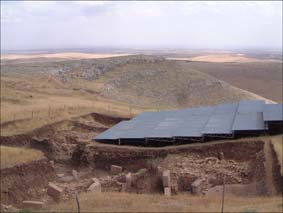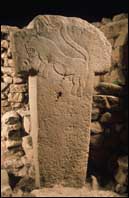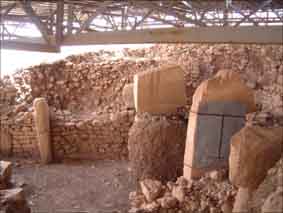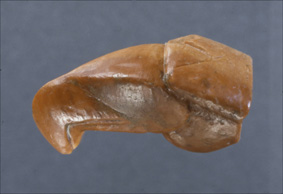![]()
![]()
GÖBEKLI TEPE - EDEN, HOME OF THE WATCHERS
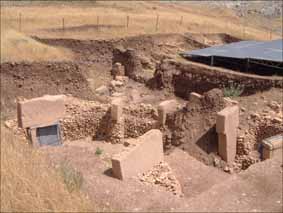
Göbekli Tepe today, its cult buildings exposed to the elements (pic: Andrew Collins).
Adriano Forgione, editor of HERA magazine, interviews Andrew Collins on Göbekli Tepe, the Oldest Temple in the World, constructed as early as 11,500-11,000 years ago in southeast Turkey. Is it the true Garden of Eden?
Can you describe the main architectural characteristics of Göbekli Tepe?
It is made up of a
series of three main sub-surface rectilinear structures defined by dry-stone
walls, and containing many decorated T-shaped pillars. These stones
served primarily as roof supports, although a symbolic purpose can not
be ruled out. In one 'cult building', as these structures are known,
is a ring of free standing pillars, their edges radiating out from a
central point, like the spokes of a wheel.
|
Could you explain to our readers why Göbekli Tepe was a "sacerdotal" site? Göbekli Tepe can be described as sacerdotal, in that it was clearly utilised as a place of veneration and perhaps communication with supernatural entities and domains. This is accepted by the main excavator Dr Klaus Schmidt of the German Aarchaeological Institute of Istanbul. Curiously, in the Turkish language Göbekli Tepe means 'hill of the naval', suggestive of the site's former role as an important religious centre serving a large catchment region. |
Göbekli Tepe looking south (Pic: Andrew Collins) |
How is it possibile that a hunter/gatherer society suddenly transforms itself to be able to build such a magnificent megalithic site with no equals in the world?
I strongly suspect that the transition was engineered by an extremely powerful and very cunning shamanic or priestly-based ruling elite, who knew how to easily manipulate and motivate the local population. It would have required a considerable work force of hundreds of people to have costructed sites such as Göbekli Tepe, and this has to have been controlled by a ruling body of immense persuasiveness. The question remains as to where this elite might have come from, and whether independent evidence of their existence can be found anywhere. The main indication would be sites of proto-agriculture experimentation that predate the PPN sites of Upper Mesopotamia (northern Syria, northern Iraq and southeast Turkey), c.11,500-11, 000 BP (before present).
I suspect the original homeland of the incoming shamanic elite was on the Upper Nile in Egypt and the Sudan, where some indication of proto-agriculture was found during the excavation of sites belonging to the Isnan and Qadan peoples of 15,000 to 11,500 years ago. However, today this evidence has been seriously called into question, making a migration route for these people more difficult to establish. I still suspect that the individuals repsonsible for Göbekli Tepe came out of Africa, and migrated into Upper Mersopotamia via what is today the foothills and mountains of northern Israel, southern Lebanon. However, there might also be a link with the Cro-Magnon cave artists of Western Europe, or even incoming peoples from China and South-east Asia (after the work of Stephen Oppenheimer in his book EDEN IN THE EAST (1998)). We should keep an open mind at this time, for evidence of proto-agriculture is emerging earlier and earlier all over the world.
The antiquity of the site is amazing considering the complexity of the advanced culture shown by the site. How do you explain such an advanced culture 11,000 years ago?
There is no obvious explanation for a high culture existing in Upper Mesopotamia at the end of the last Ice Age, when the rest of the world was still populated by hunter-gathering communities concerned with day-to-day survival, and little more. However, these faceless individuals, known to archaeologists as the Pre-Pottery Neolithic (PPN) peoples, created some of the most mesmeric art in the ancient world, which would not be bettered for thousands of years.
I suspect that the proposed priestly or shamanic-based ruling elite entered the region and came across a basic hunter-gathering society ripe for change at the end of the last Ice Age, and so they simply engineered their transition into settled farming communities. Elevated sites such as Göbekli Tepe and Nevali Çori became their civil and ceremonial nerve centres, all as part of the so-called Neolithic revolution or explosion which essentually began here, before spreading out across the Eurasian continent. It is my belief that the trafficking between the suspected ruling elite and the peoples of Upper Mesopotamia is the story found in the Book of Enoch, where beings called Watchers are said to have gone amongest mortal kind giving them the forbidden arts and sciences of heaven. These were said to have included the use of herbs and plants, metallurgy, the fashioning of weapons, female beautification, and astronomy, many of the firsts accredited to the Early Neolithic world in Upper Mesopotamia.
|
The excarnation frescoe as seen on a wall at Çatal Hüyük. On the left, the vultures protect the head, representing the seat of the soul. (Pic: Andrew Collins) |
Similar stories exist in the myths and legends of Sumeria, which speak of gods called Annunaki coming among mortal kind and providing them with the rudiments of civilization. I believe there is strong evidence to suggest that the Watchers, and their offspring the Nephilim, were indeed the shamanic elite that founded the early Neolithioc cult centres of Upper Mesopotamia. They are repeatedly referred to in pseudepigraphical literature as birdmen, and we know that the Neolithic period's highly prominent cult of the dead was focused around excarnation, and the use of the vulture as a symbol of both astral flight and the transmigration of the soul in death. Clear carvings and depictions of vultures, as well as representations of birdmen, have been found at Göbekli Tepe and other PPN sites in SE Turkey and North Syria. |
At Göbekli Tepe was found the first temples with totemic symbols.
Could you explain us which kind of cult was celebrated there and which
is the meaning of those animals?
Among the carved forms in high reliefs to be seen on stone pillars at Göbekli Tepe are anthropomorphs, felines, raptor birds, sperm-like snakes, arachnids, insects, foxes, boars and ostriches. There are so many different types of zoomorphic images that it has so far proved impossible for anyone to interpret or bracket all their intended symbolism, if indeed this is was it is meant to be.
| However, there seems to be a clear preference of interest in snakes and birds, like the vulture. Whereas the vulture is associated with death and rebirth, as it is at Çatal Hüyük - the oldest Neolithic city anywhere in the world, situated in southern-central Turkey and dating to 8500 BP - I suspect the snake played a slightly different role among the PPN communities. The snake is universally a symbol of birth, new life, transformation, cosmic creation and divine knowledge and wisdom. I also suspec that Upper Mesopotamia's cult of the dead featured the use of hallucinogenic substances, most obviously mycetes, since serpents are a universal symbol seen during mind-altered states, and examples to be seen as Göbekli Tepe and Nevali Çori sport heads that closely resemble highly-psychotropic mushrooms of the psilocybin family. |
Leonine pillar discovered at Göbekli Tepe (Pic: German Archaeological Institute) |
Do you really believe that through the correct study of Göbekli Tepe we will be able to understand the origins of the biblical narration?
Göbekli Tepe is the oldest stone temple anywhere in the world, and has to be a key to understanding the symbolism of the story of the Garden of Eden.
|
Most southerly cult building at Göbekli Tepe (pic: Andrew Collins). |
It is strange that the snake appears as an important symbol in the Book of Genesis's story of Adam and Eve. Here in the Old Testament it symbolizes the knowledge of awareness that Adam and Eve are naked, and that they should cover themselves. I feel it is a metaphor for the manner in which the incoming ruling elite of Upper Mesopotamia, the suspected Watchers of the Book of Enoch, gave mortal kind forbidden knowledge, which forever changed the way they thought about life. However, it was a case of too much knowledge too soon, and so Adam and Eve were cast out of Eden, which we know to have been a real kingdom focused on Lake Van, a huge inland sea in Eastern Turkey. From here the Euphrates and Tigris, two of the rivers of paradise, take their course before flowing down into Iraq's Fertile Crescent. |
Indeed, author and archaeologist David Rohl - a colleague of yours - is convinced that Göbekli Tepe is the biblical Eden. Do you agree with him? If so, how could you explain this relationship?
David is very familiar with the themes outlined in my previous books FROM THE ASHES OF ANGELS (1996) and GODS OF EDEN (1998), which cite the original Garden of Eden as an area encompassing mainly Upper Mesopotamia (Southeast Turkey, Northern Syria and Northern Iraq). In his own book LEGEND (1998) David saw the land of Eden as a much bigger region covering not only the whole of Upper Mesopotamia, but also large parts of Western and Northern Iran and Armenia as well. He was adament that I was wrong about my choice of area, since it contradicted his own theories on the four rivers of paradise, said to flow out of the land of Eden. If David now believes that Göbekli Tepe is the Garden of Eden, then he has changed his position somewhat. Yet I suspect he is correct, for I say more-or-less the same thing in THE CYGNUS MYSTERY, which opens with my own visit to Göbekli Tepe in 2004.
What was the relationship between the centres of Göbekli Tepe,
Nevali Çori and Çatal Huyuk?
The main relationship between key PPN sites such as Göbekli Tepe and Nevali Çori is the fact that their layout, design and art are the same. They were constructed by the same unique race of people. They connect with Çatal Hüyük because this was a latter development of the same high culture, and so this city - excavated first in the early 1960s by British archaeologist James Mellaart - can tell us much about the earlier cults at places such as Göbekli Tepe and Nevali Çori. Like, for example, the Neolithic cult of the dead. At Çatal Hüyük we find frescoes of vultures accompanying the soul of the deceased into the next world, and also of shamans taking the form of vultures for presumed shamanic practices, such as contacting or journeying into the other world. Since statues of birdmen, as well as those of vultures, have been found at both Göbekli Tepe and Nevali Çori, we can be pretty sure that the same cult existed here as far back as 11,500-10,000 BP.
Could you tell me about the stone Karibu that guards the tree of
life? This reminds me a lot of the cherub that guards the Ark of the
Covenant and a similar image found also among the Babylonians. Is Göbekli
Tepe really the origin of those biblical symbols?
Karibu and Cherubim are the same - angelic beings, and ultimately their roots can be traced back to memories of the priestly or ruling elite at places such as Göbekli Tepe. Clearly, there is more to the story of the cherub that guards the Tree of Life in the Garden of Eden, for it might also relate to either archaeoastronomy or a global catastrophe around the end of the last Ice Age. Much more knowledge about this epoch is contained in the Book of Enoch and Book of Giants, both found among the Dead Sea Scrolls and probably first recorded down in the region of Southeast Turkey, where Abraham, the ancestor of the Hebrew race is said to have come from. A cave shrine marking his alleged place of birth can be visited in Sanliurfa (Urfa, the ancient city of ancient Edessa), where various PPN sites have been discovered. There is powerful evidence, supported by David Rohl, to demonstrate that Sanliurfa, ancient Urfa, was the original Ur of the Chaldees, where Abraham is said to have been born. It is very possible that the story of the Watchers, as found in the Book of Enoch, was carried out of Upper Mesopotamia, the true site of Chaldea, when Abraham and his family, the ancestors of the Israelites and Jews, set out from the city of Harran on their epic journey to Canaan, the future land of Israel.
I read also that at Göbekli Tepe has been found one of the first
representations of an angel. Could you tell me about it? Do you think
that this site could be connected with the WATCHERS?
|
I can only repeat what I have said above. We are talking about a cult of birdmen, vulture shamans, who would eventually be remembered as the Watchers of the Book of Enoch and the angels of biblical tradition. No 'angel' has been found at Göbekli Tepe, simply carved statues of men with wings on their backs. These hybrids are likely to be shamans wearing wings, not supernatural beings. It is worth noting that originally angels never had wings - these were added to existing stories by the early Christians during the fourth century AD. In fact, there are some accounts of Watchers wearing cloaks of feathers, which in one case was altered in Christian times to read 'wings' instead of feathers. The adaptation is clumsy, and obvious in its intent. |
Carved stone vulture head found at Göbekli Tepe (Pic: German Archaeological Institute) |
I also read about the discovery of similar temples of the same age at Karahantepe, Sefertepe and Hamzantepe. It was a truly widespread society for the time, and it could antedate the birth of the Neolithic Age in the area, according also to the discovery of the Balikligöl statue. What do you think about it?
There are several new PPN sites being investigated at the moment in Eastern and Southeast Turkey, and hopefully much new evidence will emerge in due course. Two PPN sites were recently unearthed actually inside the city limits of Sanliurfa. Sadly, these examples were destroyed, with only a few items being preserved for posterity. One site was Balikligöl, where the idol was discovered. It is a giant ithyphallic male. What it represents is anyone's guess, although it has to be connected with fertility and fecundity of the land.
Much more important is Karahan Tepe, a site only discovered in the late 1990s and still awaiting full excavation. This is located near Sogmatar on the Harran Plain, and dates back 11,000 years at least. Already a large number of t-shaped pillars and stone rows have been uncovered here, and it was their orientation north and east-north-west that made me realise the significance of the Pre-Pottery Neolithic mindset in Upper Mesopotamia. I began to find that the earliest Neolithic cult centres, the prototypes of stone circles and chambered barrows everywhere, were directed roughly north-south. Since the north was a direction of death and rebirth at Çatal Hüyük, I quickly realized that the focus of attention at places such as Karahan Tepe and Göbekli Tepe was the movement of circumpolar stars around the northern celestial pole, for there was no Pole Star in c. 9500-9000 BC. I looked closely at the Skyglobe astronomical program for these dates, and realised that only one constellation could have been the object of their gaze, and this was Cygnus, which in European starlore is the celestial swan. However, there is clear evidence that in Ancient Mesopotamia Cygnus was seen as a raptor bird, while in classical myth it was occasionally seen as a vulture, the symbol of the transmigration of the soul in the Neolithic cult of the dead.
When I also discovered that the Sabians of Harran - a race of people known also as the Chaldeans who inhabited Upper Mesopotamia many thousands of years after the Pre-Pottery Neolithic peoples vanished from the radar - venerated the north as the Primal Cause and also the direction of heaven, I knew I was on to something. The results of that investigation are to be found in THE CYGNUS MYSTERY, which forces us to re-evaluate everything we thought we know about our early ancestors' understanding of the cosmos, and our place in it.
Andrew Collins' THE
CYGNUS MYSTERY is published by Watkins Publishing, London, October
2006. To order your signed and numbered copy now, click here.
![]()
![]()
